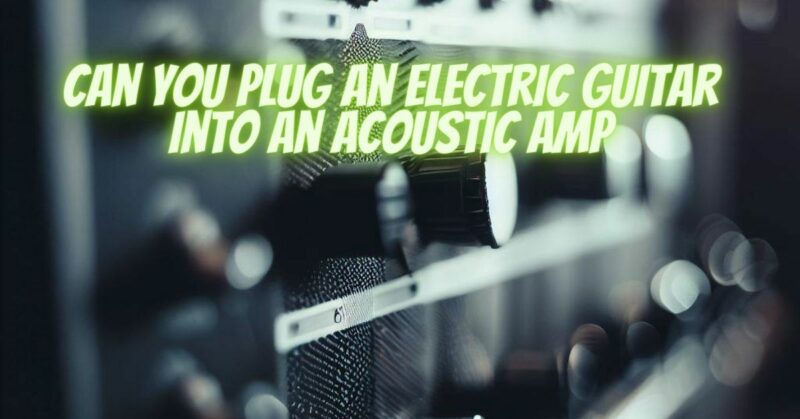Electric guitars and acoustic amplifiers are two pivotal components in the realm of music. While electric guitars are designed to work with amplifiers tailored to their electronic outputs, acoustic amplifiers are typically optimized for the subtle nuances of acoustic instruments. This article explores whether it is feasible and advisable to plug an electric guitar into an acoustic amplifier, delving into the technical, tonal, and practical implications.
Technical Compatibility
At the most fundamental level, the answer is yes—you can plug an electric guitar into an acoustic amp. Both electric and acoustic amps are designed to amplify signals from a guitar, and most amplifiers have a standard 1/4″ input jack compatible with electric guitars.
However, the key differences lie in their design and intended usage:
- Electric Amps: Built to handle the higher output and dynamic range of electric guitars. They often include features like overdrive, distortion, and equalization controls tailored for electric guitar tones.
- Acoustic Amps: Designed to reproduce the natural sound of acoustic instruments faithfully. They typically have a flatter frequency response and may include features like anti-feedback controls and inputs for microphones.
Tonal Differences
When plugging an electric guitar into an acoustic amp, several tonal characteristics and limitations emerge:
- Clean Sound: Acoustic amps are optimized for clean, uncolored sound. Therefore, an electric guitar will produce a clean tone that may lack the warmth and character provided by an electric amp’s preamp and tone shaping capabilities. This can be beneficial for genres or playing styles that prioritize clean tones, such as jazz or classical.
- Distortion and Effects: Acoustic amps are not designed to handle high-gain signals, which are essential for genres like rock, metal, and blues. They lack built-in overdrive and distortion effects common in electric guitar amps. While external effects pedals can be used, the resulting tone may not be as satisfying or authentic as with a dedicated electric guitar amp.
- Frequency Response: Acoustic amps are engineered to reproduce a wide frequency range accurately, which is perfect for the complex harmonics of acoustic instruments. This flat response can make an electric guitar sound somewhat sterile compared to the tailored response of electric amps, which often emphasize mid-range frequencies crucial for electric guitar tone.
Practical Considerations
Several practical factors should be considered when deciding to use an acoustic amp with an electric guitar:
- Portability and Convenience: Acoustic amps are often more portable and versatile, featuring inputs for microphones and other acoustic instruments, making them suitable for solo performers or small gigs. For a guitarist who occasionally plays electric and acoustic sets, using a single amp could be convenient.
- Performance Context: In a band setting, where the electric guitar needs to cut through the mix, the lack of drive and tonal shaping in an acoustic amp can be a significant drawback. For solo performances or quieter ensemble settings, this may not be as critical.
- Sound Reinforcement: Acoustic amps are often designed with sound reinforcement in mind, offering DI (Direct Input) outputs for connecting to PA systems. This can be an advantage in live settings where the amp acts more as a stage monitor and the PA system handles the main sound output.
While it is technically possible to plug an electric guitar into an acoustic amp, the tonal and practical implications suggest that it is not always the best choice for all scenarios. For clean, uncolored tones and simple setups, an acoustic amp can suffice. However, for achieving the distinctive overdriven and dynamic sound of an electric guitar, a dedicated electric amp remains the superior choice.
Ultimately, the decision should be guided by the specific needs of the player, the context of the performance, and the desired tonal outcome. Experimentation can also yield unique sounds that blend the qualities of both acoustic and electric amplification, offering a creative avenue for guitarists seeking new sonic textures.

